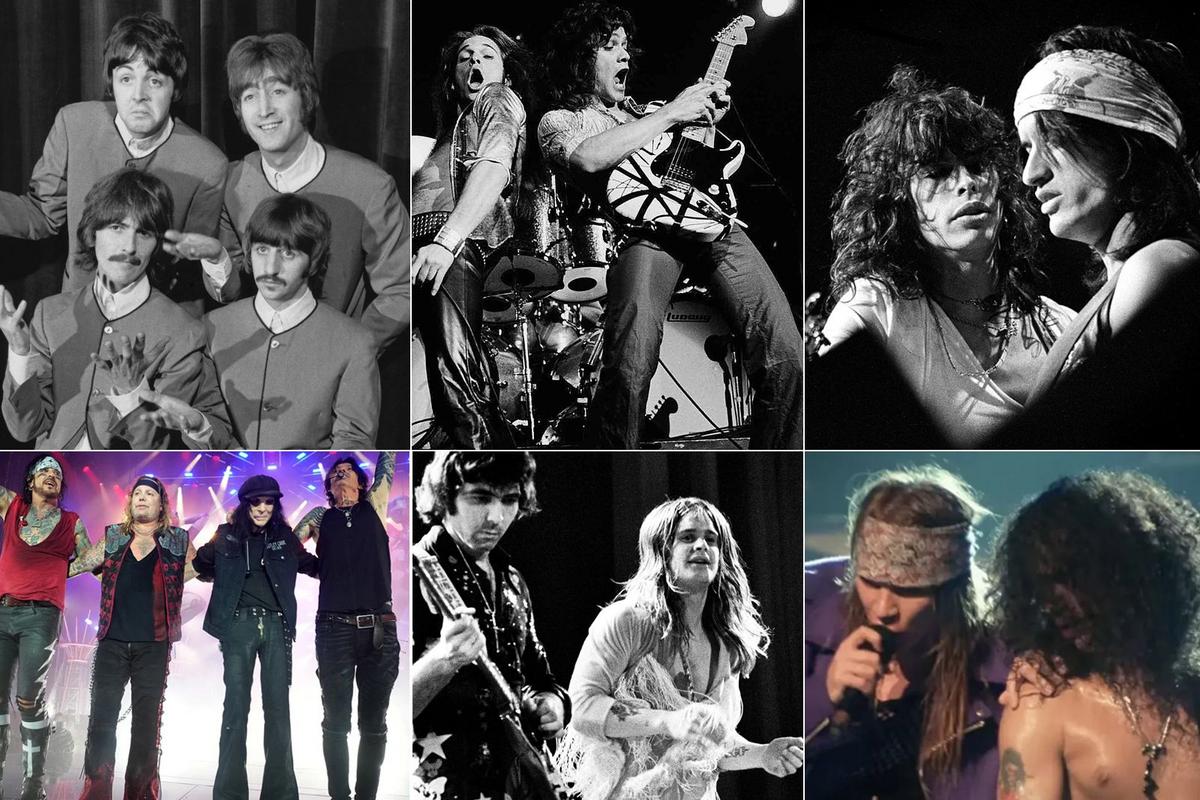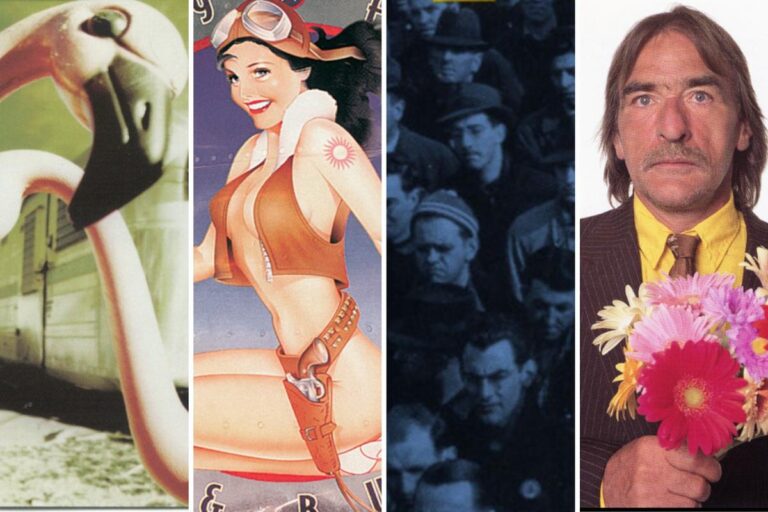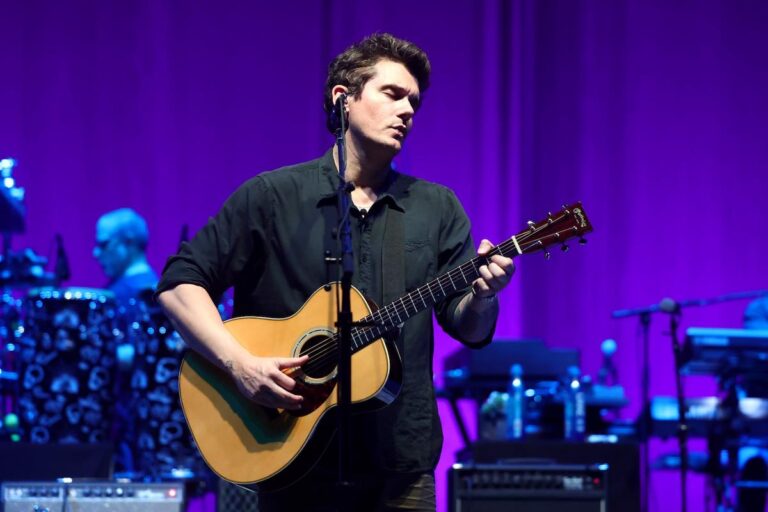Ever since the early ’70s, live albums have been an important part of rock history.
Multi-platinum breakthroughs such as Peter Frampton‘s Frampton Comes Alive!, Kiss‘ Alive! and Cheap Trick‘s At Budokan turned those three artists into superstars, and most of the genre’s biggest stars have at least one great, career-defining stand-alone live album in their catalog.
Most, but not all. As you’ll see below, the Beatles never got a fair shot at finding out what they could have achieved as a live band. As for the other five artists on this list, apparently the tapes weren’t rolling when they were at their formidable onstage peaks.
Here’s our list of six legendary bands who haven’t (yet?) released a great live album:
The Beatles
Official releases:
The Beatles at the Hollywood Bowl (1977)
Live at the Hollywood Bowl (reissue, 2016)
There’s a simple reason the Beatles, largely considered the most important band in rock history, don’t have a great live album in their discography: Their overwhelming fame pretty much forced them to stop touring very early in their career.
Fed up with not being able to hear themselves over thousands of constantly screaming fans, playing on inadequate sound systems in sometimes dangerous settings, the Beatles played their last full concert on Aug. 29, 1966. That was less than a month after the release of Revolver, an album whose songs were already too sophisticated to be included in their set lists.
In 1977, producer George Martin attempted to capture the excitement of the Fab Four’s 1964 and 1965 shows with the Hollywood Bowl album, but due to that combination of primitive equipment and overwhelming crowd noise the album succeeds largely as a nostalgic exercise, even when it was remixed to a much higher standard in 2016.
The unauthorized and extremely low-fidelity Live! at the Star-Club in Hamburg Germany; 1962 was also released in 1977, although the Beatles eventually successfully sued to get control over those master tapes and have so far kept them out of print.
Van Halen
Official releases:
Live: Right Here, Right Now (1993)
Tokyo Dome Live in Concert (2015)
Live in Dallas 1991 (2025)
In the biggest years of their career, Van Halen apparently spent more time thinking up clever names for tours than they did recording any of the shows. Stunningly, there are no official live albums featuring the band’s original lineup of Eddie and Alex Van Halen, David Lee Roth and Michael Anthony.
Three tantalizingly great promotional videos were shot and released from the band’s 1981 show in Oakland. Rumors have long persisted that those shows were also fully recorded, but that has never been confirmed.
Prior to the band’s 2015 tour, the third to feature a returning Roth and Eddie’s son Wolfgang Van Halen on bass instead of Anthony, Eddie Van Halen attempted to assemble a live album from bootleg tapes of their early days performing at clubs. “We tried our best to make them sound good,” he told the Washington Post, “but ultimately it wasn’t good enough to put out.”
Van Halen instead released the warts-and-all Live at the Tokyo Dome, taken from a 2013 concert and presented without post-production audio enhancement. Sammy Hagar, certainly not above taking shots at his predecessor, spoke for many fans when he mentioned that the album’s vocals were “pretty rough” in spots. “What the fuck are these guys thinking?”
As for the Hagar era, the home video release Live Without a Net, shot on the 1986 5150 tour, would fit the bill if it was released as a stand-alone live album. The 40th anniversary of that tour is in 2026, maybe that will be the next step in the band’s reissue campaign?
1993’s Live: Right Here Right Now is too focused on the For Unlawful Carnal Knowledge album to serve as a career-defining live document, and Live in Dallas 1991 features an abbreviated set from that same tour.
Read More: The Best Way to Watch or Hear Every Van Halen Tour
Guns N’ Roses
Official releases:
Live ?!*@ a Suicide (EP, 1986)
Live Era ’87-93 (1999)
Released a year before Guns N’ Roses‘ Appetite for Destruction flipped the entire rock world on its ass, the Live Like a Suicide EP isn’t actually a live album and features none of the songs that would make the band famous, as cool as it is.
Released six years after the Use Your Illusion tour ended, Live Era ’87-’93 is an overblown, overdubbed and mostly spark-less disappointment, largely recorded without founding members Izzy Stradlin and Stephen Adler.
Guns N’ Roses’ home video lineup is equally spotty – the two-volume Use Your Illusion World Tour – 1992 in Tokyo home video collection features the bloated “horns and backup vocalists” lineup of the band in a rather uninspiring performance. 2014’s Appetite for Democracy is often dubbed worse than an old Japanese monster movie.
Your best bet, which is certainly not a budget-friendly option, remains the Use Your Illusion Super Deluxe box set, which features both CD and Blu-Ray versions of the band’s very cool 1991 concert at the Ritz in New York City. Let’s hope they professionally recorded and filmed some of the early shows of the 2016 reunion tour for future release.
Motley Crue
Official releases:
Live: Entertainment or Death (1999)
Carnival of Sins Live (2006)
The End: Live in Los Angeles (2016)
Given the incredible hot streak Motley Crue were on with their ’80s studio records, it makes some degree of sense that they never released a live album recorded entirely at a concert from that decade. But it’s still a missed opportunity.
A decade later they released 1999’s Live: Entertainment or Death, which was patched together from shows recorded as far back as 1982, and doesn’t fully gel together.
2006’s Carnival of Sins Live and 2016’s The End: Live in Los Angeles are musically sharp but marred by singer Vince Neil’s increasingly odd vocal delivery. Besides, both titles work better in their simultaneously released home video forms, as stage design, lighting and Tommy Lee’s drum stunts are obviously a big part of any Motley Crue show.
The November 2025 Theatre of Pain box set is set to include a full-length live album from the band’s 1985 tour, which could turn out to be just what fans have been looking for.
Aerosmith
Official releases:
Live! Bootleg (1978)
Classics Live! (1986)
Classics Live! II (1987)
A Little South of Sanity (1998)
Rockin’ the Joint (2005)
Aerosmith deliberately set out to make their first live album, 1978’s Live! Bootleg, sound and look like a bootleg, right down to the tape hiss. Which is a valid creative choice, but also regrettable since it’s the only live album the band released in the ’70s. Also, truth be told it was recorded maybe one tour too late to catch them during their first peak.
After their former label released the lackluster Classics Live! without their participation, a newly reunited Aerosmith took over and made Classics Live! II much better, particularly on a smoking version of “Movin’ Out.” But even that album is too short and too fragmented to be considered definitive.
Just as Live! Bootleg captured the band just past the peak of their ’70s run, 1998’s contractually-mandated A Little South of Sanity catches them on the downside of their incredible ’80s run, with a set list clogged by second-level recent singles. 2005’s Rockin’ the Joint has a much more focused set list, but suffers from an overall slickness.
The band has a solid track record in terms of full-length live home videos, with 2004’s You Gotta Move, 2013’s Rock for the Rising Sun and 2015’s Aerosmith Rocks Donington 2014 all worth your time and money. And the VHS and laserdisc-only Live Texxas Jam ’78 is way overdue for a Blu-ray release.
Black Sabbath
Official releases:
(Ozzy Osbourne on vocals unless specified otherwise)
Live at Last (1980) / Past Lives (2002)
Live Evil (1983) (Ronnie James Dio on vocals)
Cross Purposes Live (1995) (Tony Martin on vocals)
Reunion (1996)
Live at Hammersmith Odeon (2007) (Dio on vocals)
Live… Gathered in Their Masses (2013)
The End: Live in Birmingham (2017)
Here’s the story in a nutshell: Black Sabbath didn’t release an official live album featuring Ozzy Osbourne on lead vocals until 1996. Reunion is certainly very good, but a bit too mannered and too late in the game to be called career-defining great. 2013’s Live… Gathered in Their Masses and 2017’s The End: Live in Birmingham (recorded at the band’s last full-length concert) are similarly admirable and enjoyable but not essential.
Moving backwards, the truncated and somewhat iffy Live at Last was originally released without the band’s permission. Ronnie James Dio’s early stint in the band is captured well on both Live Evil and Live at Hammersmith Odeon, but the live setting only occasionally elevates the material. The Tony Martin era is captured in a favorable enough light on Cross Purposes Live, but it falls short of time capsule-worthy material.
There are a handful of full-length home videos from the band, including 1978’s Never Say Die!, which captured the nadir of the first Ozzy era, and Black and Blue, which finds the Dio-fronted band splitting time with Blue Oyster Cult. Hopefully somebody will recut 1999’s frustrating The Last Supper without the interview interruptions someday.
In recent years, expanded editions of classic Sabbath albums such as Paranoid (Live in Montreux 1970 and Live in Brussels 1970), Vol. 4 (Live in the UK 1973) and Sabotage (North American Tour Live ’75) have been released with enjoyable, if often somewhat raw, live concerts from the appropriate eras.
Top 100 Live Albums
These are more than just concert souvenirs or stage documents from that awesome show you saw last summer.
Gallery Credit: UCR Staff



